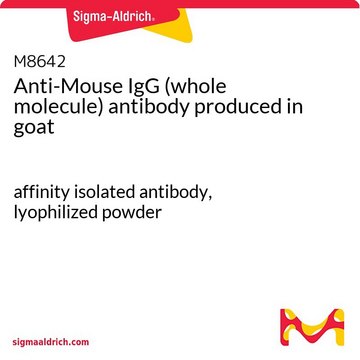76085
Anti-Mouse IgG - Atto 594 antibody produced in goat
~1 mg/mL protein, affinity isolated antibody
Sinonimo/i:
Atto 594 - goat-Anti-mouse IgG
About This Item
Prodotti consigliati
Origine biologica
goat
Coniugato
Atto 594 conjugate
Forma dell’anticorpo
affinity isolated antibody
Tipo di anticorpo
secondary antibodies
Clone
polyclonal
contiene
50% glycerol as stabilizer
Reattività contro le specie
mouse
Concentrazione
~1 mg/mL protein
Fluorescenza
λex 603 nm; λem 625 nm in PBS
Condizioni di spedizione
wet ice
Temperatura di conservazione
−20°C
modifica post-traduzionali bersaglio
unmodified
Descrizione generale
Affinity isolated antigen specific antibody is purified from goat anti-mouse IgG antiserum to remove essentially all goat serum proteins, including immunoglobulin. Goat anti-mouse IgG associates with mouse IgGs.
Immunogeno
Applicazioni
Risultati analitici
Note legali
Esclusione di responsabilità
Non trovi il prodotto giusto?
Prova il nostro Motore di ricerca dei prodotti.
Codice della classe di stoccaggio
10 - Combustible liquids
Classe di pericolosità dell'acqua (WGK)
WGK 1
Punto d’infiammabilità (°F)
Not applicable
Punto d’infiammabilità (°C)
Not applicable
Dispositivi di protezione individuale
Eyeshields, Gloves
Scegli una delle versioni più recenti:
Possiedi già questo prodotto?
I documenti relativi ai prodotti acquistati recentemente sono disponibili nell’Archivio dei documenti.
I clienti hanno visto anche
Articoli
Immunoblotting (Western blot transfer) is a common technique in modern proteomics research.
Il team dei nostri ricercatori vanta grande esperienza in tutte le aree della ricerca quali Life Science, scienza dei materiali, sintesi chimica, cromatografia, discipline analitiche, ecc..
Contatta l'Assistenza Tecnica.









